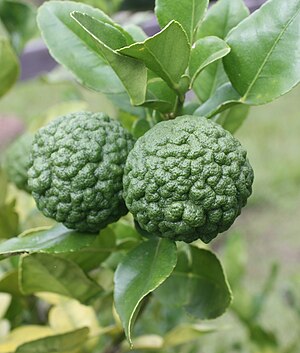コブミカン
Kaffir lime/ja
| Kaffir lime/ja | |
|---|---|

| |
| 木の上の果物 | |
| Scientific classification | |
| Kingdom: | Plantae |
| Clade: | Tracheophytes |
| Clade: | Angiosperms |
| Clade: | Eudicots |
| Clade: | Rosids |
| Order: | Sapindales |
| Family: | Rutaceae |
| Genus: | Citrus |
| Species: | hystrix
|
| Binomial name | |
| hystrix | |

| |
| 主要な柑橘類栽培品種の推定される原生地の地図(C. hystrixは薄緑色で示す) | |
| Synonyms | |
| |
Citrus hystrixは、コブミカン、タイライム、またはマクルートライムと呼ばれ、熱帯東南アジア原産の柑橘類の果物である。
その果実と葉は東南アジア料理で、エッセンシャルオイルは香水製造で使用される。その皮と砕いた葉は、強い柑橘系の香りを放つ。
名称

最も可能性の高い語源は、カフィア族を経由するものである。彼らはスリランカの民族集団で、一部は奴隷化されたバンツー族の子孫である。最も古い既知の言及は、1888年のエマヌエル・ボナヴィアによる『The Cultivated Oranges, Lemons Etc. of India and Ceylon』という本に、「caffre」という別の綴りで記されている。「プランテーションのクーリーたちは、ヒルを避けるために足や脚にこれを塗る。そのためセイロン[スリランカ]では、Kudalu dchi、つまりヒルライムという名前も付けられている。ヨーロッパ人はそれをカフィアライムと呼ぶ」。同様に、H.F.マクミランの1910年の著書『A Handbook of Tropical Gardening and Planting』には、「セイロンの『カフィアライム』」と記されている。
別の語源としては、インドのイスラム教徒が東方の非イスラム圏から輸入した果物に、直接「異質性や異国情緒」を伝えるために名付けたという説がある。この果物の名前が、南アフリカの民族的蔑称である「カフィア」(下記「南アフリカ」参照)に直接由来するという主張は、十分に裏付けられていない。
C. hystrixは、その原産地で様々な名前で知られている:
- ジャワ語ではjêruk purut、マレー語ではlimau purut(それぞれインドネシア語とマレーシア語に導入されている)は、果実のでこぼこした質感から「いぼ状の/皮が粗いライム」を意味する。
- 中国語ではjiàn yè chéng(箭叶橙「矢の葉ライム」)。
- フィリピンではkabuyawまたはkulubot。ラグナ州のカブヤオ市はこの果物にちなんで名付けられた。
- Kolumichai、コングタミル語でகொலுமிச்சை
- タイではmakrudまたはmakrut(มะกรูด、/máʔ.krùːt/)(ベルガモットオレンジにも使われる名前)。
- ラオスではmak khi hut(ໝາກຂີ້ຫູດ、/ma᷆ːk.kʰi᷆ː.hu᷆ːt/)。
- ベトナムではchúcまたはchanh Thái。
- レユニオン島ではcombava
ミクランサは、フィリピン原産の同様の柑橘類で、キーライムやペルシャライムなど、いくつかの雑種ライムの祖先であるが、C. hystrixのゲノム特性評価は、明確な結論を出すには不十分な詳細さでしか行われていないため、同一種であるかどうかは断定できない。
南アフリカ
南アフリカでは、アラビア語のkafirが白人植民地主義者によって、黒人アフリカ人に対する民族的蔑称である「カフィア」として採用された。結果として、一部の著者は「カフィアライム」から、あまり知られていない「マクルートライム」への切り替えを推奨しており、南アフリカでは通常「タイライム」と呼ばれている。
特徴
C. hystrixは、高さ2 to 11 metres (6 to 35 ft)のとげのある低木または小高木で、芳香があり、独特の形をした「二重」の葉を持つ。この砂時計型の葉は、葉身と平らな葉状の柄(植物学的には有翼の葉柄)から構成されている。果実はごつごつしていて緑色だが、熟すと黄色くなる。表面がでこぼこしていて、幅約4 cm (2 in)と小さいのが特徴である。果実は厚い皮(果皮)を持ち、非常に酸味が強く、わずかに苦味がある。花は4枚から5枚の白い花弁を持ち、香りがよい。
歴史
ピエール・ソネラ(1748年~1814年)は1771年~72年にその標本を採集し、ラマルクの『Encyclopédie Méthodique』(1796年)にも登場する。
マクルートライムは、1868年にセイロンで「カフィアライム」という名前で文献に登場する。そこでは、その汁を足や靴下に擦り込むことでヒルに噛まれるのを防ぐとされている。これがリーチライムという名前の由来である可能性がある。
Uses
Culinary
C. hystrix leaves are used in Southeast Asian cuisines such as Indonesian, Laotian, Cambodian, and Thai. The leaves are the most frequently used part of the plant, fresh, dried, or frozen. The leaves are widely used in Thai cuisine (for dishes such as tom yum) and Cambodian cuisine (for the base paste "krueng"). The leaves are used in Vietnamese cuisine to add fragrance to chicken dishes and to decrease the pungent odor when steaming snails. Also, in Vietnamese villages that harvest silkworms, the silkworms in the pupa stage are stir-fried with the kaffir lime leaves. The leaves are used in Indonesian cuisine (especially Balinese cuisine and Javanese cuisine) for foods such as soto ayam and are used along with Indonesian bay leaf for chicken and fish. They are also found in Malaysian and Burmese cuisines.
The rind (peel) is commonly used in Lao and Thai curry paste, adding an aromatic, astringent flavor. The zest of the fruit, referred to as combava, is used in creole cuisine to impart flavor in infused rums and rougails in Mauritius, Réunion, and Madagascar. In Cambodia, the entire fruit is crystallized or candied for eating.
Medicinal
The juice and rinds of the peel are used in traditional medicine in some Asian countries; the fruit's juice is often used in shampoo and is believed to kill head lice.
Other uses
The juice is used as a cleanser for clothing and hair in Thailand and occasionally in Cambodia. Lustral water mixed with slices of the fruit is used in religious ceremonies in Cambodia.
Makrut lime oil is used as raw material in many fields, including pharmaceutical, agronomic, food, sanitary, cosmetic, and perfume industries. It is also used extensively in aromatherapy and as an essential ingredient in various cosmetic and beauty products.
-
Striped snakehead fish stuffed with C. hystrix and lemongrass in preparation for steaming
-
C. hystrix leaves floating in tom yum
-
Fruit longitudinal section
-
Dried fruit rinds
-
Powdered fruit rind, used in Malagasy cuisine
-
Cut leaf strips on chicken phanaeng
-
C. hystrix leaves for sale in Phou Puy Wholesale Vegetable Market in Battambang, Cambodia (August 2022)
Cultivation

C. hystrix is grown worldwide in suitable climates as a garden shrub for home fruit production. It is well suited to container gardens and for large garden pots on patios, terraces, and in conservatories.
Main constituents
The compound responsible for the characteristic aroma was identified as (–)-(S)-citronellal, which is contained in the leaf oil up to 80 percent; minor components include citronellol (10 percent), nerol and limonene.
From a stereochemical point of view, it is remarkable that makrut lime leaves contain only the (S) stereoisomer of citronellal, whereas its enantiomer, (+)-(R)-citronellal is found in both lemon balm and (to a lesser degree) lemon grass, (however, citronellal is only a trace component in the latter's essential oil).
Makrut lime fruit peel contains an essential oil comparable to lime fruit peel oil; its main components are limonene and β-pinene.
毒性
C. hystrixは、果皮と果肉の両方にかなりの量のフロクマリンを含んでいる。フロクマリンは、潜在的に重度の皮膚炎症である植物光線皮膚炎を引き起こすことが知られている。C. hystrixの外用によって誘発された植物光線皮膚炎の症例が報告されている。
関連項目
| この記事は、クリエイティブ・コモンズ・表示・継承ライセンス3.0のもとで公表されたウィキペディアの項目Kaffir lime(28 June 2025, at 19:50編集記事参照)を翻訳して二次利用しています。 |






